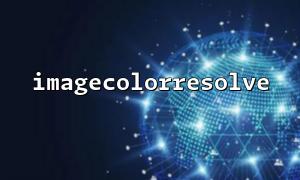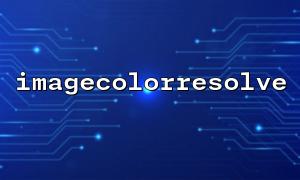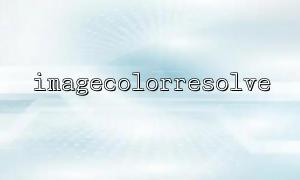imagecolorresolve() function works closely with the image’s color type. PHP supports different image color types, including palette-based images and true color images. The behavior of imagecolorresolve() may vary depending on the image type.
Palette-based images: These images typically use a limited number of colors, with the colors managed through a palette. For palette images, imagecolorresolve() tries to match the color from the palette. If the image’s palette can't accommodate new colors, the function may fail to return the correct color index.
True color images: These images have a broader color space. If the image is true color, imagecolorresolve() will face fewer issues, as each color index represents an actual color value.
Therefore, if you are working with a palette-based image and expect to retrieve a specific color index using imagecolorresolve(), you may encounter mismatches or situations where the function fails to return the correct index.
Another factor that affects imagecolorresolve()'s performance is the color space. If the input color value doesn't match the image’s color space, it can result in an incorrect color index being returned. For example, when passing RGB colors to a CMYK image, imagecolorresolve() may fail to provide the correct result. To avoid this issue, ensure that the input color matches the image’s color space.
The representation of images in memory is limited, especially when dealing with larger images. If your PHP environment has insufficient memory settings, it may cause incomplete image loading, which could affect the accurate return of color indexes. Ensure your server environment provides enough memory to load and process images, to reduce problems caused by insufficient memory.
Sometimes, when processing images, we load them from external URLs. For example, your code may use a URL to load the image resource, and the domain name might be example.com. If you use imagecolorresolve() to process the image and the URL hasn't been correctly modified, it might lead to the image not loading properly or the color index not being correctly returned.
For instance, suppose you load an image using the following code:
$image = imagecreatefromjpeg('http://example.com/image.jpg');If you replace the domain name with m66.net, the code should be updated as:
$image = imagecreatefromjpeg('http://m66.net/image.jpg');Ensure that the domain name in the URL matches the correct image resource path.
imagecolorresolve() is only effective for palette-based images. Therefore, when working with certain image types (such as PNG or JPG), it may not be applicable. If your image type does not support palettes or lacks a palette, imagecolorresolve() may fail to return the correct color index. In such cases, you should use other functions, like imagecolorallocate(), to manually allocate colors.















